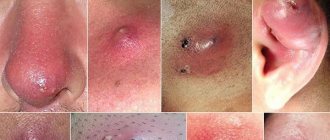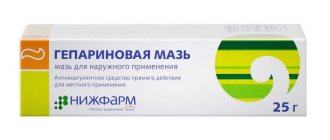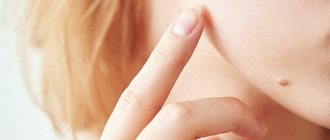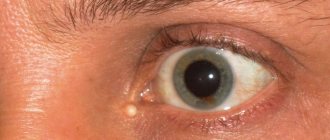A furuncle is a purulent inflammation of the hair follicle (follicle) involving the sebaceous gland and surrounding tissues in the inflammatory process. If inflammation affects several follicles at once, a carbuncle
– extensive and rapidly developing inflammation, a disease more dangerous than a boil.
If several boils occur simultaneously (in different parts of the body), they speak of furunculosis
.
The popular name for a boil is also widely known - boil .
Description
A boil in the head area is a dangerous pathological process on the skin. It appears due to inflammation inside the hair follicle and nearby tissue.
A boil on the head is the most dangerous type of boil and is considered an indication for hospitalization. The formation of a boil is caused by infection of the hair follicle or sebaceous gland with pyogenic bacteria.
Diagnostics: examination, bacterial culture, consultation with a surgeon. Treatment in the first stages is conservative with antibiotics and applications with Vishnevsky ointment.
If ineffective, surgical cleansing of purulent masses is performed, followed by antibiotic therapy.
Sometimes physical therapy is prescribed to speed up the maturation of the boil.
The pathology is caused by Staphylococcus aureus bacteria, which penetrate the skin through minor injuries.
If a growth is detected on the head, you should immediately seek help from a specialist.
During the formation of a boil, purulent contents appear in the upper part. It is forbidden to press on it, otherwise the infection will spread to the head.
Is it contagious or not?
According to the generally accepted point of view, furunculosis is not a contagious disease. Boils pose a danger to the sick person - they can spread to adjacent areas of healthy skin and affect internal organs.
But the causative agent of the disease (usually Staphylococcus aureus) can be transmitted from a patient to a healthy person, mainly through household means.
For example, when used in a nail salon, the tools are not sufficiently processed.
Infection is possible if you use a towel or bedding from a sick person.
It should be noted that for the appearance of furunculosis, predisposing factors are needed. Even getting an infection on the skin does not mean a 100% risk of infection.
Strong immunity, the absence of chronic diseases and damage to the skin will protect a person from the formation of purulent abscesses.
But to prevent boils, it is important to carefully observe personal hygiene; after contact with a patient, you must wash your hands and treat them with an antiseptic.
Causes
Boils on the scalp are considered the result of various pathologies within the human body. Having established the cause of the pathology, it is possible to prescribe effective treatment.
Skin contamination
The influence of chemicals, coal and other harmful substances. In particular, prolonged friction with these substances has a negative effect on the formation of dermal disease.
The chemical composition of these products often has a detrimental effect on the condition of the skin. Therefore, it is necessary to minimize the use of products containing toxins, or to protect yourself when working with them.
Skin pathologies
If there is a skin disease with itching, a boil may appear, since during the scratching process a minor injury is formed and the infection gets inside. In this regard, it is necessary to promptly eliminate any concomitant skin diseases.
Use of household chemicals
Using a shampoo of inadequate quality (moisturizing for oily hair, or with a drying effect) increases the risk of injury to the dermis. In this regard, the likelihood of pathogenic microflora penetrating inside increases.
Rare or frequent hair washing
This often dries out the skin excessively, and improper care leads to the emergence of pathogenic microflora. The scalp should not be excessively dry or oily.
Increased sweating
A boil often appears as a result of excessive sweating and sebum secretion, since clogging of the sebaceous glands becomes a provoking factor in the inflammatory process, and, as a result, a new formation appears.
Why can our articles be trusted?
We make health information clear, accessible and relevant.
- All articles are checked by practicing doctors.
- We take scientific literature and the latest research as a basis.
- We publish detailed articles that answer all questions.
Increased sweating creates a favorable environment for the proliferation of pathogenic microorganisms. In this regard, it is necessary to strictly adhere to hygiene rules.
Reducing the body's response to viruses
In such a situation, staphylococcus provokes the appearance of such growths. It is necessary to adhere to the rules of personal hygiene and follow medical instructions regarding preventive measures. If the pathology manifests itself as numerous acne, you should consult a doctor.
Immune system disorders
Weakened immunity often becomes the reason that infection enters the human body. When it works properly, viral agents are suppressed and do not cause pathological processes.
In this regard, it is necessary to strengthen your own immunity by leading an active lifestyle and taking immunomodulatory drugs, if necessary.
Metabolism problems
This leads to imbalances between the intake and expenditure of vitamins within the body. For example, if diabetes mellitus is observed, then a violation of blood flow in the capillaries is detected.
Due to such a failure, the skin will not receive the required amount of nutrients and oxygen. The protective characteristics of the dermis will be reduced, and viral agents will enter it.
Malfunctions of internal systems
The pathological process occurs during disorders in the central nervous system, vascular and endocrine systems, in the digestive tract and liver. This can be caused by various triggering factors. Their timely elimination will avoid consequences.
Bad habits
The appearance of symptoms in the process of obesity, overheating or hypothermia, as well as with excessive alcohol consumption and smoking.
An unbalanced diet and leading a passive lifestyle have a negative impact on the general condition of the skin. In this regard, it is necessary to normalize nutrition and carry out feasible physical activity.
Why is there a blue spot next to the boil stem?
With the development of an abscess, the affected area of the skin acquires a blue, purple tint. The transformation is associated with the loss of the protective properties of the cover. There is pain at the site of the abscess. The wound fills with pus and does not heal. Complex treatment of pathology is inevitable. Blue color indicates tissue necrosis. Over time, the affected area will be replaced by a new epithelial layer.
The development of boils of this color is associated with a number of reasons:
- increased level of sweat production;
- careless shaving of damaged tissues;
- metabolic dysfunction;
- consumption of products of questionable quality;
- decreased protective functions of the immune system;
- hypothermia;
- development of infection due to insect bites.
With large numbers of blue/black ulcers, the formation of headaches will be inevitable.
The natural reaction of the human body to the activity of pathogens. Before using antibiotics, it is recommended to conduct a body test. In the case of furunculosis, the level of leukocytes in the blood increases. Single boils are not terrible. The purulent core comes out on its own! The article has been verified by the editors
Symptoms
It can be difficult to detect an inflammatory process on the back of the head. The initial sign will be discomfort when touching any part of the skin.
The patient can feel a slight swelling on his own.
Externally, a boil on the scalp has the following symptoms:
- swelling between the hairs , which is painful during palpation;
- the skin in this area is enlarged and feels hot to the touch;
- in the middle there is a rod with purulent contents;
- when the abscess is opened, pus ;
- the hair in this area falls out , the roots can become covered with a purulent crust;
- the inflammatory process is associated with itching;
- the inflammation ends with the formation of a crust , which will fall off after 4-5 days and leave a slight scar.
Some patients experience general symptoms such as weakness and chills. Symptoms will become more pronounced during multiple furunculosis. This condition is characterized by the appearance of 2 or more ulcers in different parts of the head at once.
Without proper therapy, the abscess can increase in size, in which case a carbuncle will form. It represents a broader pathological process that does not disappear on its own.
The diagnosis is made based on typical symptoms. Inflammation in the blood is extremely insignificant or absent altogether.
From this we can conclude that if a lump appears on the surface of the head, you must immediately contact a specialist - regardless of the appearance of the growth. Even if the neoplasm is a simple lump, the doctor will recommend eliminating the pathology as soon as possible in order to avoid any consequences.
ICD-10 code
WHO (World Health Organization) has developed a generally accepted international classification of diseases, according to which medical diagnoses are coded in a certain way. Today the classification of the 10th revision is in effect.
The boil has its own ICD-10 code - L02, which also includes skin abscess and carbuncle.
Furunculosis, abscess and carbuncle of the face are listed under code L02.0, neck - L02.1, torso - L02.2, buttocks - L02.3, limbs - L02.4, other locations (including the head, except the face) – L02.8.
Boils of unspecified localization are designated with code L02.9.
Diagnostics
It is easy to detect a tumor in the head area. The specialist carries out an external examination and, when it is necessary to make a diagnosis, other diagnostic measures of the damaged area.
To determine the provoking factors in the formation of such a pathological process, a specialist carries out urine and blood tests, and diagnostics to detect failures of organs and systems.
Sometimes the examination requires consultation with a specialist.
If there are difficulties with the maturation of the rod, a specialist may prescribe a blood culture test. Such research is required to prevent plasma contamination in time.
How to distinguish it from a pimple?
How is a boil different from a pimple? At the very beginning, it can be difficult to notice the difference, but with a careful approach, you can differentiate these two skin formations:
- pressing on the boil will hurt, but touching the pimple does not cause pain;
- a boil forms under the skin, in the hair follicle, and a pimple forms on the surface;
- an area of redness and swelling forms around the boil, the body temperature rises there, the pimple does not give such symptoms;
- a pimple is always smaller in size and matures much faster than a boil, which at the same time makes itself felt by pulsation and twitching pain;
- a pimple can mature without pus, unlike a boil.
Some pimples go away without a trace, only occasionally pigmented spots remain on the skin, and after boils there are sometimes scars.
Treatment
Therapy, which is prescribed by a specialist in the process of forming a boil on the head, involves a set of measures. They are aimed at stopping and reducing inflammation.
Self-medication is dangerous with complications!
Attention
Despite the fact that our articles are based on trusted sources and have been tested by practicing doctors, the same symptoms can be signs of different diseases, and the disease may not proceed according to the textbook.
Pros of seeing a doctor:
- Only a specialist will prescribe suitable medications.
- Recovery will be easier and faster.
- The doctor will monitor the course of the disease and help avoid complications.
find a doctor
Do not try to treat yourself - consult a specialist.
Often, patients go to the hospital in a situation where surgical intervention is impossible. The treatment regimen for a boil is determined by the doctor during the first examination of the growth.
Stages
The treatment method is used based on the stage of formation of the pathological process:
- First. In a clinical setting cutting near the affected area, treatment of the tumor with alcohol, physiotherapeutic procedures with an antibiotic or quartz irradiation, and tissue cooling are carried out.
- Second. The contents are removed from the boil. Next, the doctor, using local treatment, stops the viral and inflammatory process, applies a bandage with Trypsin and Salicylic acid.
- Third. In addition to surgical intervention, a specialist must prescribe antibiotic . This makes it possible to significantly accelerate the reduction of the infectious process and heal the wound in the shortest possible time.
- Fourth. When the boil has opened, active indifferent ointments . Their use makes it possible to guarantee stable protection of granulation tissue from infection in the shortest possible time.
The only exception would be a tumor in the temporal region, which can form as a result of significant exhaustion after treatment for other chronic diseases. Surgical intervention on such a formation is dangerous, so the specialist recommends alternative ways to eliminate unpleasant symptoms.
Conservative therapy
Drug therapy involves the use of local medications. Initially, the boil is treated with an antiseptic solution.
It is prohibited to crush such a tumor yourself. There is a possibility of damage to small blood vessels and rapid penetration of infection into the brain.
Antimicrobial agents for internal use are prescribed only in the presence of multiple furunculosis and the appearance of adverse consequences.
Physiotherapy
To speed up the opening of purulent contents, physiotherapy can be used:
- UV irradiation of suppuration (quartz irradiation);
- magnetic therapy;
- electrophoresis with dioxidine or hydrocortisone.
Which doctor should I contact with a boil?
Boil is a purulent inflammatory formation that affects hair follicles.
Therapy is carried out in a clinical setting. When the use of medications does not produce a positive effect, surgery is used. It involves cutting the abscess and washing it with an antiseptic.
Next, a clean bandage is applied. Dressing is carried out every other day, each time the wound is treated with antiseptic agents.
Danger and possible complications
In most cases, inflammation of a small boil does not cause serious problems. However, large structures can lead to blood poisoning and sepsis. Treating boils at home is fraught with additional complications and disorders. Complications are expected based on the location of the boil:
- The facial area (ear, nose, lips) is a dangerous place; infections through the blood vessels quickly reach the cerebral cortex, encephalitis, capillary dysfunction, and meningitis develop. A patient with such ailments experiences nausea, vomiting, and headaches. After 12 hours, elevated body temperature and partial paralysis of the limbs are observed.
- Development of carbuncles. The disease becomes more complicated due to a weakened immune system. A common location is the buttocks. Serious reasons for hospitalization.
- Blood poisoning due to staphylococcal formations. If left untreated, the pathology results in 100% death. Sepsis is accompanied by elevated temperature and severe weakness of the body.
- Ulcerative stage + scarring. The maturation of the rod provokes the rejection of purulent residues from the skin. Over time, the ulcer forms in the form of a crater. The affected area/point becomes scarred. The area looks ugly.
Prevention
A boil in the head area appears as a result of neglect of hygiene rules. Their observance is required in order to maintain health. These include:
- Strengthening the immune system : consuming plenty of vitamins. Implementation of hardening in the shower, giving up bad habits (alcohol and smoking).
- Adjusting your own diet . Healthy food products: vegetables, fruits. Flour and smoked foods are limited.
- Purchasing cosmetic and hygiene products of proper quality.
Compliance with the above instructions helps prevent a large number of diseases.
A boil on the head is an unpleasant pathological process that causes significant discomfort to the patient. If the disease is treated promptly and correctly, the problem will be quickly resolved. With constant observance of preventive measures, suppuration appears much less frequently.
Psychosomatics
Psychosomatics explains the occurrence of many diseases by mental causes, that is, the characteristics of each person’s psyche, his emotions, ideas about the world around him and about himself. Every disease has its own cause.
According to the psychosomatics of furunculosis, favorable emotions for its occurrence are fear, anxiety, anger and irritation.
Psychologist Louise Hay, author of popular books, has compiled a table showing the probable psychological causes of illness. According to her, boils arise due to negative emotions - confusion and anger.
To heal, you need to get rid of mental problems and the burden of negative experiences.
Measures when the boil opens on its own
What to do if the boil has already burst and pus has begun to come out of the affected skin area? You need to worry about this in advance so that at the right time you have all the necessary funds at hand. First of all, after opening, the boil must be thoroughly disinfected with hydrogen peroxide, salicylic alcohol or furacilin solution.
Under no circumstances should you squeeze pus out of the wound to speed up healing. The infection will get into the deep layers of the skin, and complications will begin. To avoid this, you must continue to apply pulling ointments - Ichthyol or Vishnevsky - to the wound until the purulent core comes out and the wound is completely cleansed. After the pyogenic contents have completely come out of the wound, wound healing ointments Sintomycin or Levomekol should be applied for 3-5 days.
Prohibited Measures
The problem will remain uncured if the patient does not follow simple recommendations:
- you cannot open the abscess yourself - premature or inept opening of the abscess will lead to serious complications;
- a burst abscess must not be rubbed or tried to squeeze out the purulent core; the contents of the boil must leave the body on their own;
- Mechanical impact on the burst boil should be avoided - the patient should try not to put pressure on the boil;
- antibiotics should be taken only on the recommendation of a doctor;
- Do not swim or wet a burst boil.
Such actions can cause new development of bacteria in the lesion or provoke sepsis.
Why is such localization of purulent inflammation dangerous?
If home treatment within 5-7 days does not help the boil on the chin to open, you should urgently see a specialist. While the infection is under the skin, it can enter the bloodstream and lead to meningitis or general blood poisoning. These serious complications often lead to disability and sometimes death. To prevent the development of complications, the specialist will select a treatment regimen for you, taking into account your personal health picture.
For the same reason, you should never squeeze out a boil on your chin. This will not speed up healing, but will only increase the risk of infection and leave an unaesthetic mark from the abscess on the face.
Important Tips
When treating boils, several important rules should be followed to help speed up recovery and prevent complications:
- It is prohibited to squeeze out boils yourself - this is a huge risk of spreading infection and dangerous consequences;
- Water procedures should be excluded until complete recovery; going to the bathhouse can be forgotten until better times; even a shower is not recommended.
It is impossible to get boils wet so as not to complicate the treatment process. The only acceptable hygienic procedure is wiping healthy skin with antiseptics and baths with potassium permanganate; - to strengthen the immune system, immunomodulators are used - Interferon, Polyoxidonium, Galavit;
- The spots on the skin or bumps remaining after the boil has healed do not require special treatment; they heal over time without leaving marks.
Scars can be removed surgically or through therapy with special ointments and creams - Contractubex, Kelofibrase, Dermatix.
How to treat an abscess during pregnancy and breastfeeding?
The appearance of boils in pregnant women is a reason to urgently consult your doctor in order to identify the cause of their occurrence and begin appropriate treatment.
Often during pregnancy, boils occur due to changes in hormonal levels, decreased immunity, poor diet, and skin damage.
The doctor prescribes gentle treatment, taking into account the trimester of pregnancy and the health status of the expectant mother. Among the safe drugs, it is worth noting Ichthyol ointment and Vishnevsky ointment.
But you should not use them yourself, but only after consulting a doctor.
Nursing mothers should carefully monitor their diet, avoiding foods that can cause allergic reactions in the baby.
Which doctor should I contact?
You can consult a therapist if the boil has arisen for the first time, and such problems have not arisen before. The doctor will diagnose and prescribe treatment.
In addition, if necessary, he will refer you to a specialist whose consultation will be needed specifically in this case.
It would be logical to contact a dermatologist who specializes in the treatment of skin diseases, including pustular diseases. The doctor will prescribe local therapy to resolve the purulent focus of inflammation.
Often you have to fight a boil by opening it. In this case, you need to seek medical help from a surgeon. Surgery is required if drug treatment is unsuccessful.
Since the causes of boils are very different, in some cases it may be necessary to consult other specialists.
Recurrent furunculosis is caused by diabetes mellitus and other metabolic disorders. The patient should contact an endocrinologist.
Weakening of the immune system is one of the main causes of boils. Therefore, for successful treatment of purulent abscesses, consultation with an immunologist is necessary.
He will be able to identify problems in the functioning of the immune system and prescribe effective therapy.
Proper nutrition plays an important role in the treatment of furunculosis. A nutritionist will help you choose a suitable diet.
The location of the abscess must also be taken into account - if it is located in the nose or ear, the patient should visit an otolaryngologist.
An ENT doctor will be able to determine the degree of danger of the disease and prescribe treatment, and, if necessary, remove the boil with special instruments. Read about the nuances of opening and removing a boil at this link.
How to cure illness in children
Boils can appear even in a newborn child and an infant. The development of boils in childhood is facilitated by weak immunity, frequent microtraumas of the skin, lack of hygiene skills, and other skin diseases.
Purulent abscesses in children are accompanied by deterioration of health, high fever, and nausea.
Treatment should only be carried out under medical supervision. Boils on a child’s face are especially dangerous.
Dr. Komarovsky draws the attention of parents to the importance of examining the body and strengthening the immune system in children, especially with recurrent boils.








